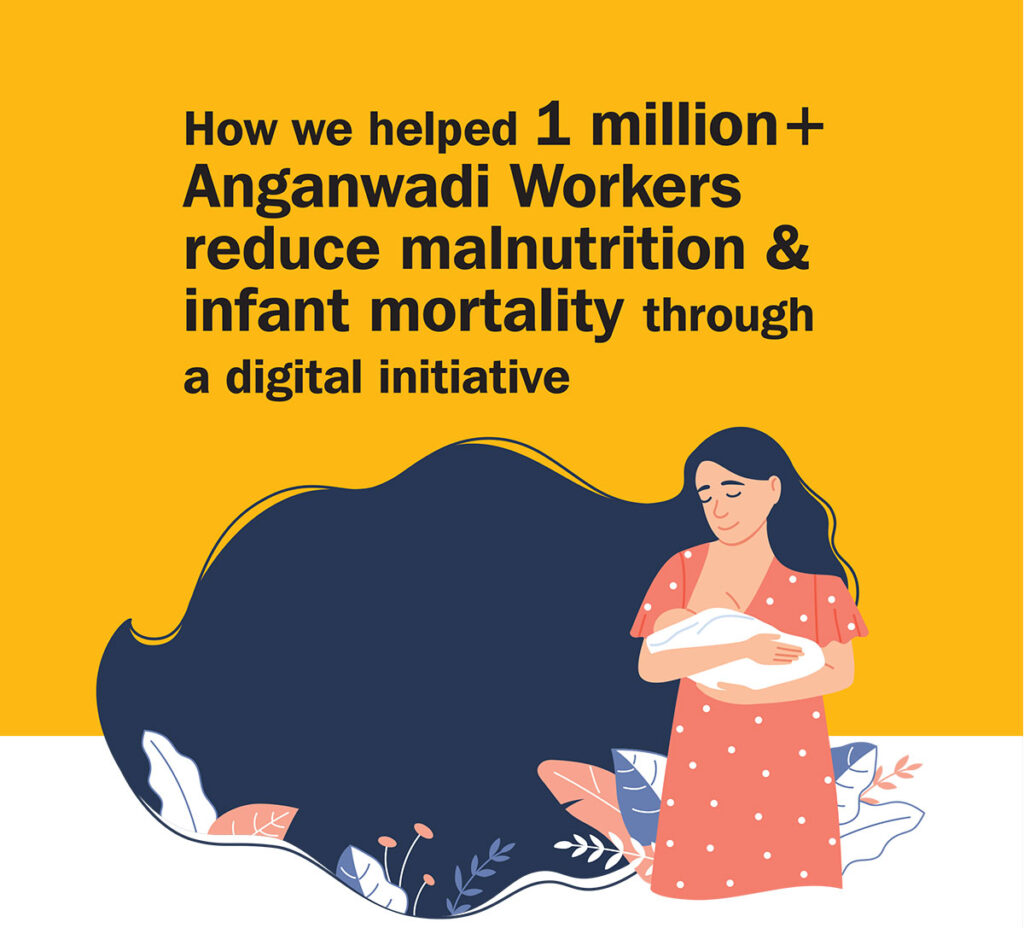
How we helped 1 million+ Anganwadi Workers reduce malnutrition & infant mortality through a digital initiative

Synopsis:
Indian children suffer from malnutrition which can be corrected through proper growth monitoring, timely intervention, and proper nutrition. A frontline force numbering 1.4 million+ Anganwadi Workers are tasked with ensuring a reduction in maternal mortality and improvement in child health, under the Integrated Child Development Services (ICDS).
Our scope of work included building a Mobile App Platform for offline learning. Learning Management System & Dashboards for tracking progress, developing mobile and eLearning content, action learning tools, formative and summative assessments to measure outcomes on the ground and peer to peer learning interactions. The assignment includes consulting with the Multi-Lateral Agency and GoI team to build a robust, sustainable, digital capacity building model.

The Situation:
The Multi-Lateral Agency is supporting the Government of India in the implementation of the ‘ICDS Systems Strengthening and Nutrition Improvement Project’ (ISSNIP), through IDA financing of US$ 86 million in eight low-income states of India, namely Andhra Pradesh, Bihar, Chhattisgarh, Jharkhand, Madhya Pradesh, Maharashtra, Rajasthan, and Uttar Pradesh.
Overall Objectives: The overall objective of this assignment is to support the Ministry in capacity building of the last mile functionary – the Anganwadi Workers (AWW), across India. Structured learning had to be delivered to ensure that the AWW deliver services required to meet the goals of the ministry. Towards this, eLearning & mLearning modules on maternal and child nutrition & growth monitoring had to be developed and delivered on a web-based and mobile application-based platform. Modular certification tests and action learning tasks associated with each of the 22 eLearning modules were to be developed and hosted on the platform. The eLearning modules were expected to complement and strengthen the incremental capacity-building approach being implemented under ISSNIP for improved knowledge, skills, convergence, and motivation of ICDS field functionaries.

The Solution:
We developed two types of learning modules on the same content at the Knowledge and Skill level. Following are the components of the learning solution:
- Training Needs Analysis, that resulted in developing a learning model over three learning levels – Know, Understand, and Apply.
- Mobile Nuggets: 3-4-minute video-based nuggets for the learners to access from their smartphone; 4 nuggets developed for each of the 22 ILA Modules based on scientifically- designed learning outcomes in 14 Indian Languages.
- Web-Based Learning Modules: 20-25 min duration of interactive content was designed and developed for better engagement with the learners, for those who have access to a Desktop / Tab / Laptop. Visually-enhanced scenarios, examples with Do’s and Don’ts, and simple problem-solving approaches were used to connect with learning who are high-action and low-cognition learners. Modules were developed in 14 Indian Languages.
- Formative and Summative Assessments were deployed at the end of each module to measure, score, and provide feedback so that the learners can be self-assured.
- Mobile App: An offline android-based mobile app was developed where the mobile nuggets were pre-packaged and pre-installed on the smartphones issued to the AWW. Basic Learner registration to access the learning nuggets, tracking learner behavior, and sync of the data when connected to the internet via WiFi was enabled.
- Learning Management System & Dashboards: An open-source software-based Learning Management System was customized and developed in Hindi & English for course, learner, assessment management with role-based dashboards.
- Solution was hosted on NIC Servers provided by the Government.

The Impact:
1.3 million+ AWW have registered for the course and over 800,000 certified, which would result in positive nutritional and growth outcomes for over 16 million children in the 0-6 years age group.



